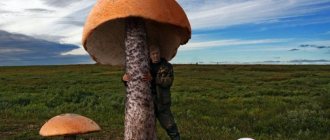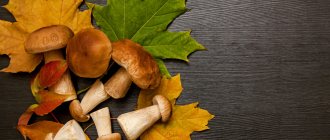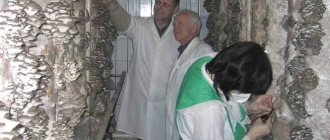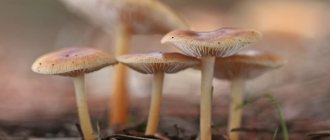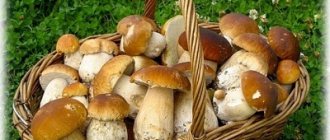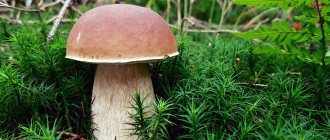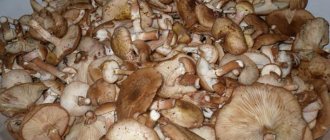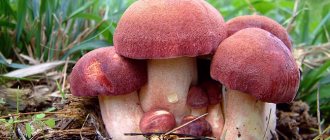The largest living organism in the world lives in the US state of Oregon. It occupies an area of more than 880 hectares, and its age is estimated at 8.5 thousand years. We are talking about the giant mycelium of the honey fungus (Armillaria ostoyae), which is not afraid of chemicals, pests and other dangers. Moreover, the mycelium itself is capable of inspiring horror - penetrating inside trees growing on the surface, like a vampire, it sucks water and nutrients from them. Scientists have been studying this huge organism for a long time and were recently able to find out why it has such amazing vitality. It turns out that when in the wild, mushroom threads are covered with a material as durable as plastic. It is this that allows the huge mycelium to survive for thousands of years more successfully than all other living creatures.
Mushrooms of the species Armillaria ostoyae
Fun fact: Mushrooms are not plants because they are unable to extract energy from sunlight. But at the same time, they cannot be classified as animals, because they do not feed through the mouth, but absorb nutrients throughout the body. Most mushrooms are connected to each other by a network of branched threads - mycelium.
Poplar honey fungus Cyclocybe Aegerita
Poplar mushroom Cyclocybe Aegerita
An edible mushroom from the genus Cyclocybe, family Strophariaceae, has been a cultivated species for a long time, and is still actively grown in Italy, where it is called “Piopino”. This mushroom is also known under the names Agrocibe Poplar and Foliota Poplar.
Appearance
The cap of young specimens is colored soft brown, has a velvety surface and a spherical shape. With age, the cap flattens, becomes lighter and becomes covered with cracks.
The hymenophore is lamellar, the plates are light yellow in color in youth, but become brownish with age. Spore powder is brown.
The stem is up to 15 cm long and up to 2 cm thick. It is a lighter shade than the cap, usually curved and connected from below to other fruiting bodies. There is a membranous ring in the upper part of the stem.
The pulp is rich, fleshy, from white to light brown in color, with a mealy taste and tart aroma.
Where and when does it grow
Cyclocybe Aegerita is grown artificially on hardwood. Primarily on poplars and willows, but also on elms, birches, elders or fruit trees. For the trees themselves, the growth of Poplar Honey Mushroom on them is a sure death sentence; the mycelium completely destroys the wood in 5 - 7 years. This mushroom is unpretentious, and anyone can now grow it with their own hands.
Culinary use
Cyclocybe Aegerita is edible, has a wonderful taste, a special “crispy” internal structure, and is highly valued in European countries. Suitable for any type of culinary processing and preparation for future use.
Poplar honey agaric is rich in the amino acid methionine, which is beneficial for the body and is necessary to maintain proper metabolism. Products based on this fungus are used to treat chronic headaches and hypertension, and the antibiotic agrocybin is used as an antibacterial agent. Lectin obtained from poplar honey mushrooms is used as an antitumor agent to combat the formation of cancer cells.
Lingzhi
The varnished tinder fungus also takes pride of place among the largest mushrooms. Residents of the small Chinese town of Hezhou managed to discover the giant. The Chinese call this mushroom lingzhi. It has been used for more than 2000 years in alternative medicine for the preparation of healing potions. The weight of the find was 7.5 kg, and the diameter of this giant reached 107 cm.
Evaluation of taste qualities, medicinal properties, benefits and possible harm
Mushrooms are often called vegetable meat, and their calorie content is minimal. Dark honey mushrooms contain a large amount of glycogen, vitamins, microelements, as well as organic acids, sugar and ash. The phosphorus content in them is higher than in cow's milk, and the potassium content is the same as in pears. Half of the dry mass is fiber.
The pulp of spruce mushrooms is quite hard, which means it will be difficult to digest. Should not be consumed by elderly people or those suffering from gastrointestinal diseases.
Important! Children under three years of age, pregnant and lactating women are prohibited from eating mushrooms. Dark honey mushrooms are used to treat tumors, during antibacterial therapy, diseases caused by Escherichia coli or Staphylococcus aureus
Able to normalize the functioning of the thyroid gland. In addition, they help remove cholesterol and do not allow it to linger in the blood vessels, and the low glycemic index allows them to be consumed by patients with diabetes mellitus
Dark honey mushrooms are used to treat tumors, during antibacterial therapy, and diseases caused by Escherichia coli or Staphylococcus aureus. Able to normalize the functioning of the thyroid gland. In addition, they help remove cholesterol and prevent it from remaining in the blood vessels, and the low glycemic index allows them to be consumed by patients with diabetes.
Chinese macromycete (3rd place)
A distinctive feature of this unique microorganism, discovered in the Chinese region of Yunnan, in addition to its exceptional size, is its non-standard shape for its species.
It seemed to consist of several hundred “mini” caps, fused together, growing from a common stem. The hat at its widest point was about 100 centimeters wide. The weight of the unusual exhibit was 15 kg.
The amazing “multi-headed” mushroom has often been photographed in various scientific and entertainment publications. At the moment, it is not included in any classifications, but this does not prevent it from claiming the title of one of the largest representatives of the genus of macromycetes.
False doubles
Thick-legged honey mushrooms belong to the autumn variety; for a long time they were even considered one organism, until scientists identified some differences.
| Name | Hat and hymenophore | Leg and ring | Smell and taste | Danger |
| Armillaria cylindrical | The scales on the cap are preserved even in adult species, the color is brownish | The ring is torn in a star shape | Cheese smell | Edible |
| Honey fungus gray | The scales quickly disappear from the cap (are washed off), the color may have a bluish tint | Ring rupture is incorrect | Mushroom smell, very fragrant | edible |
| Hairy scale | Increased number of scales on the cap, ocher spores | The ring is scaly, the leg is thin, long, narrowed downwards | The taste is bitter, the smell is pungent | Conditionally edible |
| False honey fungus sulfur-yellow | The cap is yellow with a brown tint, the plates are sulfur-yellow | Light yellow, hollow, very thin | Bitter, unpleasant smell | Poisonous |
It is not difficult to distinguish the thick-legged honey agaric from its counterparts, especially from the poisonous ones. In any case, while on a quiet hunt, you need to be extremely attentive and careful.
Candy
| Early summer, medium-yielding, partly self-fertile variety of domestic selection. The variety has good winter hardiness and scab resistance is above average. |
The tree is tall (5-7 m), fast-growing, with a powerful spreading wide dense dark green crown of a rounded shape, very resilient, requires regular pruning. Flower buds can be damaged by frost. It begins to bear fruit in the 3rd-4th year, apples are harvested in early August. Delicate fruits hold tightly to the branches and are not prone to falling, but can be significantly damaged by wasps. Fruiting is regular, annual.
The fruits are round, even in size and shape, medium in size (90-120 g), with a specific subtle caramel aroma. The color is bright yellow, densely “outlined” with a red blush. The skin is thin, the flesh is creamy, juicy, tender, fine-grained. The taste is very sweet with a spicy honey flavor. The fruits are stored without refrigeration for up to 1.5 months, somewhat losing aroma and taste in the process, and are poorly transportable.
Interesting Facts
The most incredible discovery is the discovery of a huge fungal organism in Michigan. So far nothing larger has been found. This mycelium covers an area of 15 hectares. An analysis of the fruiting bodies found along the entire perimeter of the fungal area was carried out, and it was revealed that they all originate from the same living organism. Now American textbooks study this phenomenon along with the blue whale and the giant sequoia.
The thick-legged honey fungus is found in various climatic zones and quite often ends up in the baskets of mushroom pickers. It has high taste and many different dishes are prepared from it. In addition, its high content of nutrients and low calorie content make it an indispensable part of the menu for people who watch their shape.
Where and when does it grow?
Autumn honey fungus is a saprophyte, which means it is predisposed to living on rotten stumps, trunks, and rotting foliage; it is rarely found on dying trees. Can be observed in the company of northern and dark honey mushrooms.
Among plants it prefers beech and spruce; it can be found on fir or ash, but rarely. Coniferous wood is avoided. The largest harvests of honey mushrooms can be collected in temperate climates, but they are also found in the southern regions of Russia, as well as in the Far East and the Urals.
Interesting! The number of this mushroom on one piece of land is quite high; it grows in groups, but not in bunches, like other varieties of honey mushrooms. They usually spread along the forest floor and cover the entire surface. The main harvest period is August - November.
Macromycete from Canada (4th place)
Amazing record-breaking mushrooms have been repeatedly discovered on the North American continent. One of them, a huge raincoat weighing more than 26 kilograms, was discovered while walking through the forest by Canadian Christian Therrien.
The man admitted that he had never seen such “giant mushrooms” before, so he took the find home to show it to his friends and take a photo with the unique exhibit.
Honey fungus Armillaria Ostoyae
Dark honey fungus Armillaria Ostoyae
An edible, although not very tasty species, famous for the fact that its mycelium in the American Malure Nature Reserve, in Oregon, is recognized as the largest living creature in the world - it covers an area of more than 880 hectares, and has been growing for almost two and a half thousands years. Also known as Ground Honey Honey and Spruce Honey Honey.
Appearance
The cap is up to 10 cm in diameter, initially convex, later flattened. Painted in brown or reddish-yellow tones, lighter at the edges. The remains of a fringed cover are often visible on the edge of the cap, and the top is covered with dark scales.
The lamellar hymenophore is adherent and sparse, whitish-yellow in young fruiting bodies, darker in mature ones. Ocher-colored spore powder.
The leg is single-colored with a cap, up to 13 cm in height and up to 2 cm in diameter, with a thickening at the base, with a well-defined fringed ring.
The pulp is light, without a distinct odor, and has a slightly bitter taste.
Where and when does it grow
It grows from August to November in the northern and temperate forest zones of Europe and North America. Fruits in large groups in deciduous and mixed forests in places abounding in dead wood and stumps. Fruiting bodies are often fused with stalks. Dark Honey fungus is especially dangerous for forests; its mycelium is especially successful in decomposing lignin in wood, which allows the mycelium to penetrate especially deeply and cause maximum harm to trees.
Culinary use
Armillaria Ostoyae is edible, but it is recommended to boil it for 20 minutes before eating to remove the bitterness from the pulp. After boiling, this species is suitable for any method of culinary processing, but most lovers prefer to salt or pickle it.
Taxonomy
Armillaria ostoyae
This species has long been known as Armillaria ostoyae
Romagn., until a 2008 publication revealed that the species had been described under the earlier name
Armillaria solidipes
by Charles Horton Peck in 1900,[8] long before Henri Romagnesi described it in 1970.[9]
Subsequently, a proposal to retain the name Armillaria ostoyae
was published in 2011 and approved by the Fungal Nomenclature Committee.[10] This fungus harms coniferous trees in the United States and Canada.
Growing the mycelium Armillaria gallica at home and in the country
The honey fungus is a wood-destroying organism, and therefore its cultivation is somewhat different from other forest counterparts. It is best to purchase mycelium or mycelium in a specialized store. You can grow it in two ways:
- on plant residues;
- on rotten wood or blocks.
The first option is quite simple, and this method can be used even when living in an apartment. To do this you will need:
- Place a homogeneous or combined substrate in a container and pour boiling water over it. For these purposes, you can use hay, straw or sawdust, individually or in a mixture.
- The entire composition is cooled to room temperature.
- Then decant, squeeze well and mix with mycelium. The proportions are indicated on the manufacturer's packaging, but for 100 g you will need about 40 kg of wet substrate.
- The mixture is placed in a plastic bag (its walls should be transparent). After pressing a little, you need to tie it. Make cuts along the entire surface to allow air exchange.
- This mushroom block can be placed in any convenient place. It will be best if you hang it. This can be done indoors, in the garden or on the balcony.
- Lighting is not required for mushrooms; germination period is a month. The composition will first fluff up, turn white or turn a little yellow, and then become a fairly dense block.
- After another 2 weeks, small rudiments of mushrooms will appear; light will be required here.
- In places where fruiting bodies are found, cuts are made on the film. Mushrooms will produce a harvest for up to three weeks, but the largest harvest will occur in the first two.
The second option for growing on wood is significantly different from the previous one. To do this you need:
- Soak the beams and logs prepared for growing mushrooms for 7 days. Their length can be up to 40 cm, and their diameter up to 25 cm. If the workpieces are freshly sawn, then it is enough to keep them in water for 2 days or not soak them at all.
- Holes are drilled in the prepared wood, mycelium is introduced into them and covered with tape or tape. Then they need to be covered (use straw, cotton wool, paper or other materials).
- The mycelium will grow overgrown for up to six months, and the temperature must be maintained from +7 to +27 degrees Celsius.
- Place the logs in a ventilated place; a shady garden or a room with good ventilation is suitable.
- The harvest can be obtained three times a year - twice in spring and autumn, and also in summer, if the mushrooms like the conditions.
Some mycelium manufacturers may give separate recommendations; these are usually indicated on the packaging.
Growing at home and in the country
Modern science allows you to grow honey mushrooms in your own backyard; you don’t need to look for an old honey mushroom and wait a long time for the spores to find the right tree and germinate. It is enough to purchase mushroom mycelium and fulfill the necessary conditions for growing agricultural technology.
In order to grow honey mushrooms on your site, it is enough to choose a tree that you don’t mind, because this organism will destroy it completely; a rotting or dying plant is best suited. After thoroughly wetting, plant the mushrooms and cover them with moss so that the moisture does not evaporate for as long as possible. It will be even better if the place where they are planted is shady. After a year, you can harvest the first harvest, which will appear for 7 years.
For growing in city apartments, you can use glass jars; you will also need:
- a third of the capacity of bran;
- two-thirds sawdust from deciduous trees;
- starch and flour 1 tbsp. l.
To grow you need:
- Pour all the ingredients into a container, add water and boil.
- Cool, pour into jars and plant mushrooms there.
- Close with a lid that has a hole for air access.
- When the first fruits appear, the covers need to be removed.
In just a month the first honey mushrooms will appear.
Cooking recipes
The bodies of dark mushrooms contain a little water, they are perfect for frying, but the legs are often not used for food, as they are very hard, especially in older specimens. Because of their love for coniferous trees, honey mushrooms can be a little bitter, but boiling them gets rid of this.
These mushrooms are salted, pickled, dried and frozen - they are suitable for any processing.
Primary processing
Preliminary preparation for further preparation consists of cleaning the fruits from forest debris, they should also be washed under running water and boiled for 20 minutes, draining the water after that.
Cooking
To boil mushrooms, you only need the fruits themselves, water and salt to taste. It is enough to boil the honey mushrooms in salted water twice for 20 minutes, changing the water between processes for a new one. After this, they can be cooked further or added to soup.
Pickling
For marinating, boiled honey mushrooms are used; you will need:
- mushrooms – 1 kg;
- salt – 2 tbsp. l.;
- sugar – 1 tbsp. l.;
- vinegar - 2 tbsp. l.;
- cloves – 2 buds.
Cooking process:
- Pour 1 liter of water into a saucepan, add salt and sugar, bring to a boil.
- Pour in vinegar and add cloves.
- After 2 minutes add mushrooms.
- Cook for 15 minutes.
- Place the fruits in prepared jars and pour marinade over them.
The jars should be cooled, covered with lids and placed on the bottom shelf of the refrigerator.
Freezing
Boiled mushrooms are frozen. They should cool completely and all the water should drain off. After this, the fruits are distributed into portioned containers or bags and sent to the freezer.
Important! If you freeze a large number of mushrooms in one container, then it will be difficult to separate them and get the required amount for cooking.
Frying
To make delicious mushrooms with sour cream, you will need:
- boiled honey mushrooms – 0.5 kg;
- sour cream – 5 tbsp. l.;
- onion – 300 g;
- fresh dill – 100 g;
- butter – 50 g;
- salt and pepper to taste.
Cooking process:
- Finely chop the onion and fry in a frying pan until soft.
- Add mushrooms, butter, stir, salt and pepper.
- After 5 minutes, add sour cream.
- After boiling, add finely chopped dill.
- After 2 minutes, remove from heat.
These mushrooms are best served with boiled potatoes.
Pickling
For salting, you will need previously prepared dark mushrooms, boiled in salted water. Besides:
- mushrooms – 2 kg;
- salt – 100 g;
- garlic – 6 cloves;
- black allspice – 10 peas;
- dill - 2 umbrellas.
Cooking process:
- Prepare a deep enamel bowl, line the bottom with salt, a layer of mushrooms on top, continue alternating.
- Each layer should be sprinkled with garlic, pepper and dill.
- Cover everything with gauze in two layers, press with a plate and place a weight on top.
- After 10 days, you can try the finished mushrooms.
During this time, you should periodically wash the gauze or replace it with a new one; this will preserve the harvest and prevent it from becoming moldy during the pickling process.
At the end, the mushrooms are placed in jars and closed with lids. You can store it in the refrigerator, cellar or basement.
Drying
In order to dry honey mushrooms, you should not wash or boil them. It is enough to remove debris with a soft brush and remove rotten and wormy specimens.
Mushrooms should be cut so that they are all the same size, this will allow them to dry equally intensively.
Then string all the parts on a thread and hang them in a sunny place, in a well-ventilated room or on a balcony or in the garden.
It is better to cover the top of the fruits with several layers of gauze, this way you will avoid infection by insects and dust settling.
After a week, in sunny weather, the mushrooms will be completely dried. They can be stored in a dry place, away from foreign odors.
Canning for the winter
To preserve mushrooms for a longer period you will need:
- dark boiled honey mushrooms – 1 kg;
- vinegar - 2 tbsp. l.;
- salt – 2 tbsp. l.;
- sugar – 1 tbsp. l.;
- laurel leaves – 3 pcs.;
- garlic – 5 cloves;
- black peppercorns – 10 pcs.
Cooking process:
- Add salt, sugar to 1 liter of water and bring to a boil.
- Then add bay leaf, garlic, pepper and cook for 3 minutes.
- Add mushrooms, boil for 5 minutes.
- Add vinegar, cook for another 5 minutes.
- Place the fruits in sterilized jars and fill with marinade to the top.
- Sterilize the jars for 20 minutes, then roll them up.
Such mushrooms will be stored for a long time and will delight you throughout the long winter.
Honey Mushroom False Doubles
Like many edible fruits, dark-capped honey mushrooms have their own counterparts. Some of them are edible, others are not.
| Name | hat | Leg | Danger |
| Ground honey fungus | Yellow or brown with a reddish tint | These honey mushrooms have a dark stem that matches the color of the cap. | Edible |
| False honey agaric | Bright, gray-yellow | The leg ring is missing | Inedible |
| Honey fungus swollen | Brown with yellowish or ocher hues | At the bottom the leg is swollen, brown, above it is light yellow | Edible |
| Autumn honey fungus | Colored in honey, brown and even greenish shades | Yellow-brown, darker below, covered with flakes | Edible |
As can be seen from the table, these mushrooms do not have poisonous counterparts; they are the darkest honey mushrooms. It is very easy to distinguish them, but care when collecting will not hurt.
Raincoat from England (12th place)
If you have ever claimed to have found a mushroom of incredible size, then you probably have not heard anything about the story of an amateur gardener, British woman Terri Hodson-Walker, who, during one of her walks in the forest, discovered a “non-standard” specimen of puffball or Calvatia gigantea, which had grown due to intense autumn rains to very large sizes.
The weight of the find was about two kilograms. In diameter, its cap was 46 centimeters long. The woman wanted to record an amazing find as the largest mushroom in the world and turned to representatives of the Guinness Book of Records, but she was refused, since similar records had already been described earlier.
Drying honey fungus
Honey fungus (Armillaria tabescens) is a relatively rare mushroom of the Physalacriaceae family. This variety was described in 1772. The fruiting bodies of this species are used for food and medicinal purposes. Due to the high content of biologically active substances, their use has a positive effect on the functioning of the digestive organs and other body systems.
It is believed that the mushroom is extremely useful for people who suffer from diseases of the biliary tract and liver. In addition, the active components present in this fruiting body help stabilize blood pressure and eliminate atherosclerotic plaques. These honey mushrooms also help with a number of other diseases.
Description
Shrinking honey mushrooms grow in large groups. The size of the cap of one mushroom can vary from 3 to 10 cm. The surface of the cap is beige. In young fruiting bodies it has a slightly convex shape, but later it straightens out slightly. The edges are curved. Dark scales appear on the surface of ripe caps. There is no mucus on the caps of this variety of mushrooms, even in rainy weather.
The flesh of these mushrooms is white and has a strong mushroom smell. The taste is tart. Honey mushrooms of this species have lamellar hymenophores. It has a white or pinkish tint, plates attached to the leg. Ripe fruits secrete a cream-colored spore powder. The spores are distinguished by their elliptical shape and smooth surface.
The leg is high. Its length ranges from 7.5 to 20 cm. The diameter ranges from 0.5 to 1.5 cm. The structure of the leg is fibrous. Toward the bottom it narrows greatly. The upper part of the leg is white, and the lower part is yellowish. This variety has no ring. When cut, it can be revealed that the leg is hollow.
Fruiting season and distribution locations
Drying honey fungus most often bears fruit in groups on tree trunks and branches. Often fruiting bodies appear on rotten stumps. It is noted that this variety of mushrooms prefers oak wood, although they can bear fruit on other species. Less commonly, mycelium bears fruit on the ground. Under favorable conditions, fruits begin to appear at the end of July. In the future, they can be detected until the end of October. In regions with mild climates, these fruiting bodies continue to bear fruit until the end of November.
This species is most often found in North American, Far Eastern and European forests. Special weather conditions are required for fruiting to begin. Most often, these mushrooms appear if, after a long period of heat, there is a sudden cold snap and it starts to rain. If the autumn is dry, almost no fruiting bodies are formed.
Similar types and differences from them
Drying honey fungus outwardly resembles a number of species that bear fruit at about the same time. It is necessary to distinguish these mushrooms from their doubles, since many of the similar species are classified as edible and poisonous.
This mushroom is similar to the autumn mushroom. The latter have brownish caps and grow influenza on stumps and trees, but these species can be easily distinguished. The autumn honey mushroom has a ring on its leg. In addition, this variety is much more common than the described specimens.
The drying mushroom can be easily confused with representatives of the genus of mushrooms Strophariaceae (Galerina fringed). These species are almost indistinguishable in appearance. They bear fruit at the same time. They can be found mainly under trees and on stumps.
The only pronounced difference is the color of the spore powder. In the bordered galerina it is brown. It is imperative to be able to distinguish between these fruiting bodies, because... Many representatives of the genus Strophariaceae are poisonous.
In addition, young drying honey mushrooms outwardly resemble talkers belonging to the Ryadovkov family. However, these fruits do not have the characteristic scales on their caps. In addition, they have black mycelial cords.
It is often difficult to distinguish this variety of honey mushrooms from other representatives of the Physalacriev genus. However, these fruits do not have rings on the legs, which are present in most types of autumn honey mushrooms.
Edibility
This mushroom is edible. However, these fruiting bodies should be collected only in environmentally friendly areas, because they tend to accumulate harmful substances. The fruits of this species are highly valued by mushroom pickers for their good taste.
The taste of these mushrooms is best revealed when fried or stewed. In addition, drying honey mushrooms are suitable for making soups. Fruits of this type can also be harvested for the winter. They are good for drying. These mushrooms are used for pickling and pickling.
Macrocybe
In 2005, a Mexican biologist in the United States found a macrocybe mushroom that grew between coffee trees and weighed 28 kg. Two years later, another macrocybe of impressive size was discovered on a coffee plantation in Mexico. The giant, found in 2007, towered 70 cm above the ground. Its weight was 20 kg. Now scientists are trying to determine whether coffee trees have a positive effect on mushrooms, which contributes to their rapid growth.
conclusions
- Winter apple varieties are an excellent choice for those who want fresh fruit all year round.
- Most winter species have excellent commercial qualities, making them profitable to grow for sale.
- The fruits tolerate long-term storage well. Depending on the variety, they can remain fresh until the New Year or until next summer.
- Many winter varieties are characterized by high yields. However, because of this, some trees may bear fruit once every two years. Therefore, it is necessary to regulate the number of ovaries.
- Apples can retain their softness and rich flavor, which only improves with long-term storage. Read about storing apples for the winter.
Fomitiporia ellipsoidea from China (2nd place)
In the ranking of the largest mushrooms in the world, it is worth noting a specimen from Hainan, found during mycological research in 2010.
The unique exhibit Phellinus ellipsoideus, weighing about 500 kilograms, was twenty years old, having managed to grow to a record height of 10.85 meters during this period, growing an 88-centimeter hat.
According to one of the scientists who studied the find, Professor Yu Cheng Dai, similar huge mushrooms were found earlier, in 2008, in Fujian province, but they were still far from the size of the find from Hainan.
It was found by accident, and at first the researchers could not understand what was in front of them: a giant mushroom or another formation. Visualization of the microorganism was difficult due to the fact that most of it grew underground. For this reason, they simply did not pay attention to him.
